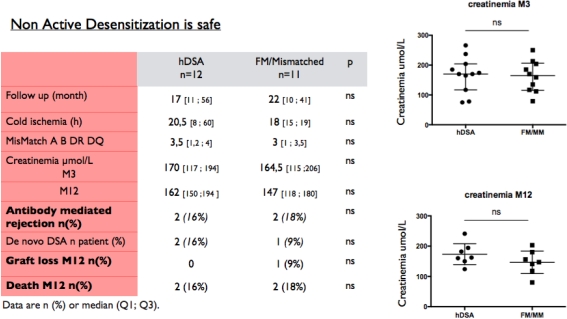Non Active Desensitization Protocol: Improving Access to Kidney Transplant for Hyperimmunized Patients
1Nephrology and Transplantation, CHU Hôtel Dieu, Nantes, France
2Laboratoire HLA, Etablissement Français du Sang, Nantes, France.
Meeting: 2018 American Transplant Congress
Abstract number: A151
Keywords: Highly-sensitized, HLA antibodies, Kidney transplantation
Session Information
Session Name: Poster Session A: Kidney Immunosuppression: Desensitization
Session Type: Poster Session
Date: Saturday, June 2, 2018
Session Time: 5:30pm-7:30pm
 Presentation Time: 5:30pm-7:30pm
Presentation Time: 5:30pm-7:30pm
Location: Hall 4EF
Hyperimmunized patients have a bad access to renal transplantation, despite national priority programs and active desensitization protocols. After having noticed that some HLA antibodies decreased spontaneously, we designed a Non-Active Desensitization (NAD), where HLA antibodies with a MFI below 3000 in the last three years were withdrawn of the unacceptable antigen list, regardless of the historical peak value. The efficacy of NAD was evaluated by the two indicators of access to transplant : cPRA and PMD (Potential Match Donor) that is the number of potential donors during the 5 last years for a given patient. Over a 9-year period, we have included 85 sensitized patients with a cPRA >95%, waiting for a transplant since 54 months (median). We have withdrawn for each patient 2 HLA-A, 6 HLA-B, 2 HLA-DR and 0 HLA-DQ antibodies (median). The cPRA decreased from 98.5% to 94.5% and the PMD rose from 5 to 53. 23 patients : 12 patients with at least one DSA in the historical sera (named hDSA). Eight patients were transplanted with 1 hDSA, one with 2 hDSA, two with 3 hDSA and one with 6 hDSA (six patients with class I, three with class II, and three with both I and II). The MFI of the DSA on the current serum was 352 (median, maximum 1792). The historical MFI peak was 9326 (median, maximum 19772) with 7 years (median) between the day of the peak and transplantation. When patients transplanted with (12) and without hDSA (11) were compared for clinical data, no difference was seen. Two patients underwent acute humoral rejection within 3 months in both groups, with good response to treatment. Two patients in each group died and 1-year post transplant serum creatinine was identical (respectively 162[micro]mol vs 147[micro]mol). Our results suggest that our NAD protocol improves patient access to kidney transplant and seems safe when the patient is transplanted even with hDSA 
CITATION INFORMATION: Le Bot S., Delbos F., Garandeau C., Malard Castagnet S., Cesbron A., Hourmant M. Non Active Desensitization Protocol: Improving Access to Kidney Transplant for Hyperimmunized Patients Am J Transplant. 2017;17 (suppl 3).
To cite this abstract in AMA style:
Bot SLe, Delbos F, Garandeau C, Castagnet SMalard, Cesbron A, Hourmant M. Non Active Desensitization Protocol: Improving Access to Kidney Transplant for Hyperimmunized Patients [abstract]. https://atcmeetingabstracts.com/abstract/non-active-desensitization-protocol-improving-access-to-kidney-transplant-for-hyperimmunized-patients/. Accessed December 18, 2025.« Back to 2018 American Transplant Congress
